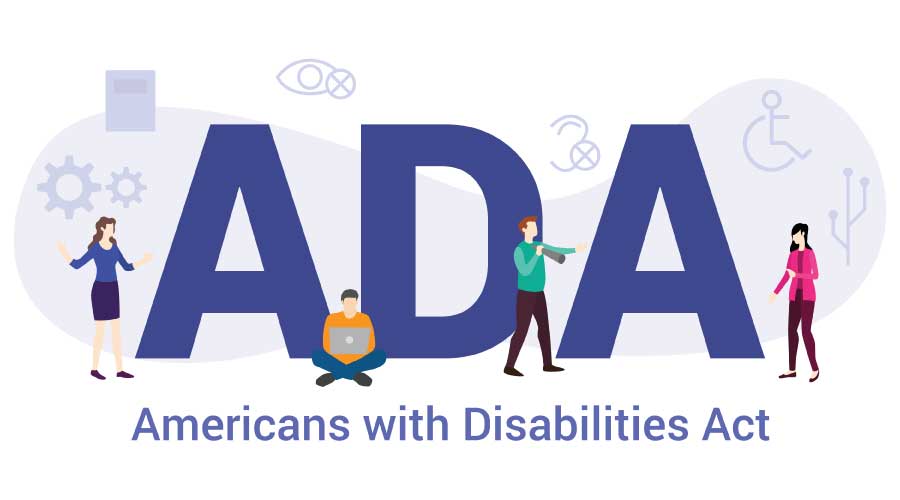Avoiding ADA Lawsuits
OTHER PARTS OF THIS ARTICLEPt. 1: This Page
There has been a rise in the number of ADA accessibility lawsuits filed against businesses and facilities for alleged violations of the Americans with Disabilities Act (ADA) over the last few years. These lawsuits have the potential to cost defendants $5,000 or more per complaint. The best defense against ADA lawsuits is to begin the process of removing accessibility barriers. Barriers are aspects of the built environment which lessen a disabled person’s access. The removal process starts by assessing what needs to be done and then putting in place plans, procedures and policies to guide implementation.
Here are four proactive steps to become an unappealing target:
1. Know how you’re doing
2. Develop a written implementation plan
3. Execute against the plan
4. Let the law be your guide
1. Know how you’re doing
The first step is to understand the basics of the ADA. Title III of the ADA addresses public accommodations and commercial buildings. This section prohibits discrimination based on disability in the full and equal enjoyment of the goods, services, facilities, privileges, advantages or accommodations of any place of public accommodation by any person who owns, leases or operates a place of public accommodation.
One of the most important things to understand is that the ADA is a civil rights law, not a building code. The enforcement of the ADA is not overseen by local building code officials. The ADA is enforced when discrimination is alleged through private suit or by certain federal agencies, such as the Department of Justice. Therefore, just because plans are approved by building inspectors or other officials does not mean the building will be ADA compliant.
To truly know how you are doing, you should consult with a professional for specific details related to your business. They can perform an accessibility audit on the facility. The audit should include the exterior and interior. The exterior audit of the property should include the path of travel from the street, parking and public transportation. The interior audit should include all areas accessed by visitors, customers and vendors.
2. Develop a written implementation plan
The data collected from the audit will then be used to create an access plan to remove barriers within your time frame. Yes, I said within your time frame. That’s the good news. Enforcement of the ADA Standards does not insist on complete and immediate compliance. On the other hand doing nothing or taking half-hearted, slipshod measures are an invitation to lawsuits and substantial penalties, damages, and costs. Barrier removal is a continuing obligation, and it’s expected that a business will take steps to improve accessibility over time.
3. Execute against the plan
The Standards require businesses to remove barriers to the extent that it is readily achievable. Many may think the term readily achievable means “to the extent it is convenient for me.” This is simply not so. The 1991 ADA Standards for Accessible Design defines readily achievable as, “easily accomplishable and able to be carried out without much difficulty or expense.” If it’s not readily achievable to immediately remove a barrier, then the business must remove barriers to the extent that it is readily achievable.
Continuing barrier removal obligations should be incorporated into both short-term and long-term business planning. Property owners and facility managers may consider incorporating previously identified and deferred barriers into their annual capital planning process. A record of this process should be part of their accessibility compliance plan.
4. Let the law be your guide
The 2010 ADA Standards for Accessible Design is more than 250 pages, but there are resources to help make use of this extensive document. A couple of good places to start are the United States Access Board website, www.access-board.gov, and the U.S. DOJ ADA website, www.ada.gov. The DOJ also offers a toll-free ADA information line for assistance.
ADA compliance is the law, but it’s also good business. Americans with disabilities represent a profitable consumer market. According to the U.S. Census Bureau there are 54 million people with disabilities in the United States. This represents 19 percent of the U.S. population, which is approximately one in five Americans. They engage in $175 billion in discretionary spending each year according to the U.S. Department of Labor.
Meeting the needs of the disabled can positively affect a company’s revenue.
In conclusion, knowledge is the key to starting your path to ADA compliance and becoming an unappealing target for ADA lawsuits. Ignorance is not a defense. Begin by educating yourself on the basic requirements of the ADA. Consult with an expert who can give you specific details related to your business and perform accessibility audits of your facilities. Then use the data collected to create a plan to execute over time and in line with your annual capital planning process. These steps could open your facilities up to an untapped market of disabled individuals and give you a defense should any ADA complaints arise.
M. Bradley Gaskins, AIA, is COO and partner at The McIntosh Group. A registered architect since 1987 in 14 states, he is NCARB certified, Past Certified Building Official, California Certified Accessibility Specialist (CASp) & ICC Certified Accessibility Inspector and Expert Witness in ADA Title III.
Related Topics:









